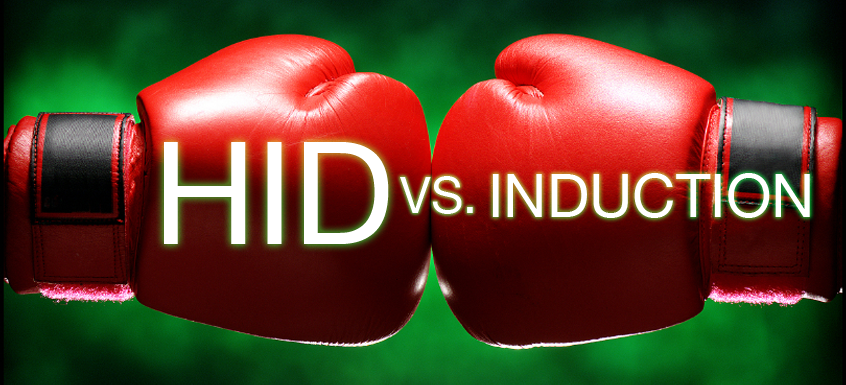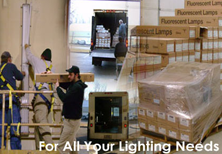Light Fights: Induction vs. HID

For the past few blog posts we’ve been running a series of “light fights,” where we evaluate two types of competing light technologies. We explore light quality, energy efficiency, cost, and more to determine the best overall lamp for common applications. In today’s matchup we’re going to compare the well-known and inexpensive HID light against the older, yet often unappreciated induction lamp.
Applications
Both HID and induction lights are typically used in commercial and industrial applications, since they can emit a large amount of light over a sizeable area. Because they have relatively long lifespans as compared to ordinary consumer lamps, they are especially useful in high-ceiling places where it is hazardous, difficult, or cumbersome to regularly replace bulbs. You’ll typically find them in warehouses, gymnasiums, stadiums, streetlamps, cafeterias, bridges, tunnels, and similar places. HIDs and inductions can operate in cold environments which also makes them suitable for freezers and cold storage environments.
Overview
Before we put inductions and HIDs head-to-head, let’s first get a better idea of what we’re dealing with by exploring how the two technologies work.
Induction Lamps
Induction lights have existed since the 19th century but only recently matured enough that they became practical for common use. They are actually a type of fluorescent light except, unlike traditional fluorescents, they don’t have the problematic electrodes. Electrodes often degrade with use (especially if switched on and off frequently) and can shorten the life of the bulb. Because induction lights don’t have the electrodes, they usually last much longer than regular fluorescents.
Instead of having metal prongs, induction lights have strong electromagnets affixed outside of the bulb. When electricity is sent to the lamp, an electromagnetic field is created inside the bulb, which excites mercury in an inert gas. The lack of metal prongs also eliminates the problem of “leaky bulbs” (caused by stripped or broken prongs) where gasses leak in and out of the lamp – disturbing the proper gas balance.
High Intensity Discharge Light Bulbs (HID)
There are multiple types of lights within the HID family, including mercury vapor (MV), high pressure sodium (HPS), and metal halide (MH). They are all a class of gas-discharge arc lamps that create light sending an electrical current between two electrodes and an ionized gas. The light emits from the arc when excited electrons change orbits as they interact with an inert gas. Usually a second type of gas is used as well, which distinguishes the type of bulb (e.g. sodium, mercury, halide). All HIDs need a ballast to regulate power, and the ballasts usually need replacing over time.
Now, for the side-by-side comparison…
Induction & HID Compared
|
Induction |
HID |
|
| Energy Efficiency | Up to 90 Lumens/Watt | 40-100 Lumens/Watt |
| Durability | Heavy-duty – has no electrode or filament, shock & vibration resistant | Fragile – has moving parts, glass bulbs, and filaments |
| Lifetime | 100,000 hours at R50 | 15,000 to 25,000 hours |
| Lumen Depreciation | 5% at 2,000 hours | 30% to 40% at 2,000 hours |
| Cold Tolerant | – 40 F (may require warm up time at low temperatures) | – 40 F (may require longer warm up time at low temperatures) |
| Performance | Turns on instantly, no flickering or glare | Needs 5-10 minute warm-up time, can flicker and glare |
| Color Temperatures | Multiple Options (2700 to 6500 Kelvin) | Limited options (3000 to 5000 Kelvin) |
| Color Rendering | Average 80 CRI | 5 to 93 CRI |
| Dimmable? | No – unless special ballast | No |
| Warranty | 3 to 10 years | 1 to 2 years |
| Cost | Moderate upfront cost | Low upfront cost, but requires regular relamping and ballast replacement |
Solution
Induction lights have had major advancements over the past few years, and based on the data above, it appears they are currently outpacing HIDs in almost every category. The HID’s energy efficiency has made it a favorite for decades, but when you look at its lumen depreciation, it’s clear that it doesn’t maintain the same level of efficiency over its lifetime. Induction lamps, however, only lose a small fraction of their lumen power and will end up using less energy over the long term.
Also, inductions lights are more durable, turn on instantly (vital in some situations), and have broader color temperatures. Although they do have a bigger upfront cost, with their energy efficiency and lack of maintenance, you should recoup the extra costs in no time.
That said, there are still a few scenarios where you may want to choose HIDs over inductions. For instance, HIDs work well in temporary, low-cost lighting applications where you don’t need a long lasting solution. Also, if you still have working ballasts and fixtures, you may want to continue using HIDs until the whole setup needs replacing.
Yet, on the whole, induction bulbs have the advantage, so expect to start seeing more of them as people continue to learn about this evolving technology.



No comments yet.